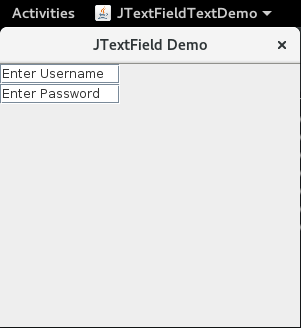Java Swing Program to demonstrate JTextField with Text
Program
import javax.swing.*;
public class JTextFieldTextDemo
{
public static void main(String args[])
{
JFrame frm = new JFrame("JTextField Demo");
JTextField txtUserName, txtPassword;
txtUserName = new JTextField("Enter Username");
txtUserName.setBounds(0, 0, 120, 20);
txtPassword = new JTextField("Enter Password");
txtPassword.setBounds(0, 20, 120, 20);
frm.add(txtUserName);
frm.add(txtPassword);
frm.setSize(300, 300);
frm.setLayout(null);
frm.setVisible(true);
frm.setDefaultCloseOperation(JFrame.EXIT_ON_CLOSE);
}
}
This Java Swing program demonstrates the use of the JTextField component with default text. JTextField is a Swing component that allows the user to enter a single line of text. In this program, two JTextField components are created: one for the username and one for the password, each with a default text displayed in the field when the program is first run.
-
Imports:
- The program imports
javax.swing.*to use Swing components likeJFrameandJTextField.
- The program imports
-
Creating the JFrame:
JFrame frm = new JFrame("JTextField Demo"): Creates a window (frame) titled "JTextField Demo".frm.setSize(300, 300): Sets the size of the frame to 300x300 pixels.frm.setLayout(null): Disables the default layout manager and allows for manual positioning of components inside the frame.frm.setVisible(true): Makes the frame visible when the program is run.frm.setDefaultCloseOperation(JFrame.EXIT_ON_CLOSE): Ensures that the program terminates when the window is closed.
-
Creating JTextField Components with Text:
txtUserName = new JTextField("Enter Username"): Creates a text field with the default text "Enter Username" displayed inside it when the program starts.txtPassword = new JTextField("Enter Password"): Creates a text field with the default text "Enter Password" displayed inside it when the program starts.
-
Positioning the JTextFields:
txtUserName.setBounds(0, 0, 120, 20): This sets the position and size of thetxtUserNamefield at coordinates(0, 0)with a width of 120 pixels and a height of 20 pixels.txtPassword.setBounds(0, 20, 120, 20): Sets the position of thetxtPasswordfield just below the username field at coordinates(0, 20).
-
Adding Components to the JFrame:
frm.add(txtUserName)andfrm.add(txtPassword): These lines add the two text fields to the frame.
-
Key Swing Methods Used:
JTextField("default text"): Creates aJTextFieldinitialized with the given default text.setBounds(x, y, width, height): Defines the position and size of the text fields within the frame.add(Component component): Adds the text fields to the frame.setVisible(true): Makes the frame visible when the program is executed.setDefaultCloseOperation(JFrame.EXIT_ON_CLOSE): Ensures that when the window is closed, the application will exit.
Output
